Table Of Contents:
- Introduction – Navigating the NFT Investment Landscape in 2025:
- NFT Staking vs. NFT Flipping – The Basics Explained:
- Key NFT Market Trends and Insights for 2025:
- The Benefits and Risks of NFT Staking:
- The Ups and Downs of NFT Flipping:
- How to Choose Between NFT Staking and Flipping:
- Pro Tips for Success in NFT Staking and Flipping:
- Real-Life Case Studies – Lessons from Top Investors:
- What’s Next for NFT Staking and Flipping?
- Choosing the Right NFT Strategy for 2025: Staking or Flipping?
- Frequently Asked Questions – NFT Staking vs. NFT Flipping:
- Q1. What is NFT staking?
- Q2. How does NFT flipping work?
- Q3. Which is better for beginners: staking or flipping?
- Q4. What fees should I watch out for in NFT staking and flipping?
- Q5. What are the risks of NFT staking?
- Q6. How can I find the best NFTs for flipping?
- Q7. Can I stake any NFT, or are there restrictions?
- Q8. Is combining staking and flipping a smart move?
- Q9. What tools and platforms should I use for staking or flipping?
- Q10. How does the NFT market’s volatility affect staking and flipping?
- Q11. What are the tax implications of NFT staking and flipping?
- Q12. How much time and effort do these strategies require?
- Q13. How can I stay informed about NFT trends?
- Q14. Are there ethical concerns with flipping NFTs?
- Q15. Is NFT flipping or staking suitable for long-term wealth building?
Introduction – Navigating the NFT Investment Landscape in 2025:
Hey there, fellow NFT enthusiasts! Remember when NFTs were just quirky digital collectibles? Well, those days are long gone. Fast forward to 2025, and the NFT market has transformed into a bustling ecosystem with a plethora of investment opportunities. Whether you're a seasoned trader or just dipping your toes into the digital waters, understanding the dynamics of NFT staking and flipping is crucial. Let's embark on this journey together to explore these strategies and help you make informed decisions in the ever-evolving world of NFTs.
The Rapid Growth of NFTs: What You Need to Know?
It's no secret that NFTs have taken the world by storm. In the first quarter of 2024 alone, the NFT market witnessed a trading volume surge to a record $3.9 billion, marking a 50% increase compared to the same period in 2023. This upward trajectory isn't showing signs of slowing down. Projections indicate that the global NFT market is poised to reach $51.4 billion in 2024 and climb at a noteworthy compound annual growth rate (CAGR) of 23%, potentially hitting $407.7 billion by 2034. Such exponential growth underscores the increasing significance of NFTs in the digital asset realm.
Why Investors Are Turning to Staking and Flipping in 2025?
With the NFT market's rapid expansion, investors are continually seeking strategies to maximize returns. Two prominent approaches have emerged: staking and flipping.
- NFT Staking: This strategy allows NFT holders to earn passive income by locking their assets on specific platforms, receiving rewards over time. As the decentralized finance (DeFi) sector evolves, staking has become an attractive option for those looking to generate steady returns without actively trading.
- NFT Flipping: On the flip side (pun intended), flipping involves purchasing NFTs at a lower price and selling them at a higher value, capitalizing on market trends and demand. This approach requires keen market insight and agility but can yield substantial profits for savvy traders.
Purpose – Helping You Choose the Right NFT Investment Strategy:
Navigating the NFT investment landscape can feel overwhelming, especially with the myriad of options available. Our goal is to demystify NFT staking and flipping, providing you with comprehensive insights into each strategy's benefits, risks, and potential returns. By the end of this guide, you'll be equipped with the knowledge to choose the investment path that aligns best with your financial goals and risk tolerance. So, let's dive in and explore the exciting world of NFT investments together!
NFT Staking vs. NFT Flipping – The Basics Explained:
The NFT world is brimming with opportunities, but two strategies stand out for their potential to grow your wealth: NFT staking and NFT flipping. Both offer unique advantages and require different skill sets, making it essential to understand how they work before diving in. Let’s break down these approaches step by step, so you can confidently decide which one aligns best with your goals.
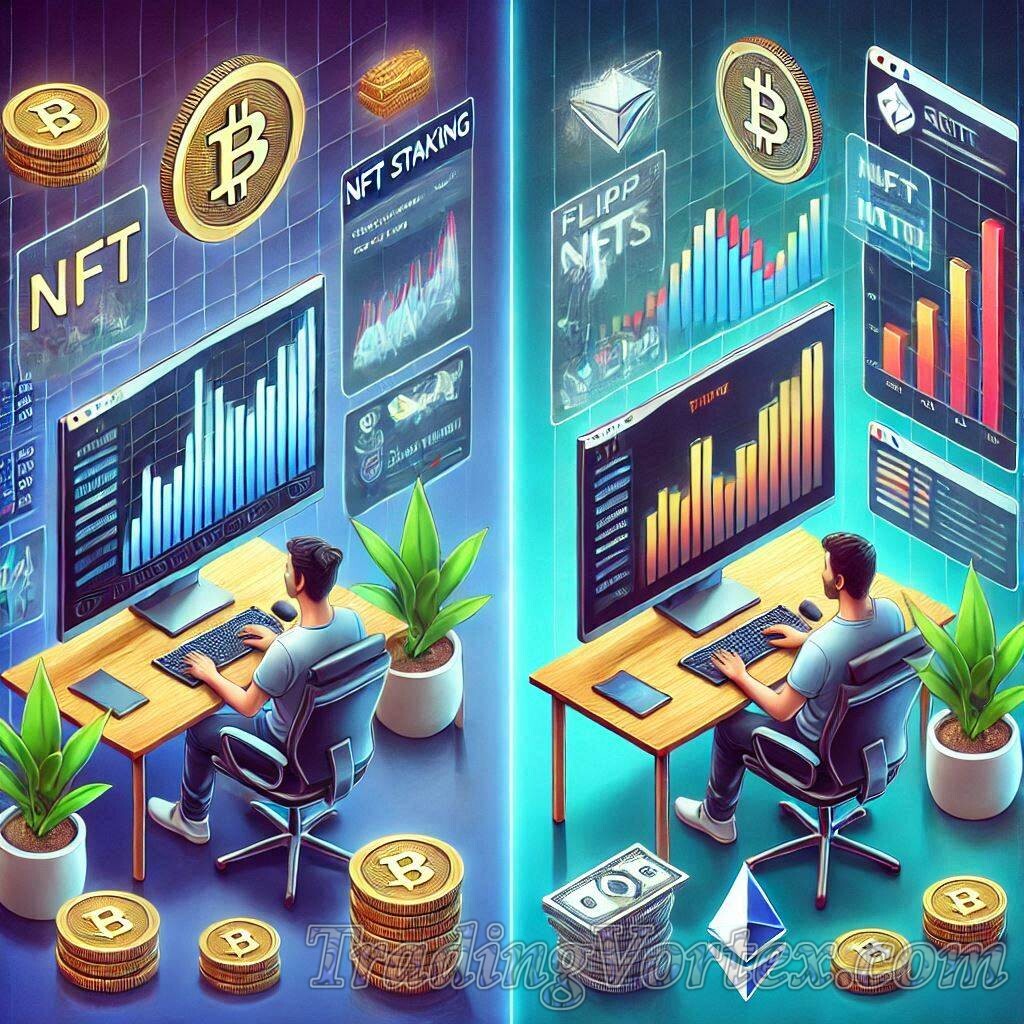
What is NFT Staking?
Definition – Turning NFTs into Passive Income:
How Staking Works? Locking NFTs to Earn Rewards:
Here’s how it works:
- Choose a Staking Platform: Select a reputable platform that supports NFT staking. Each platform has its own set of rules and rewards structure.
- Lock Your NFT: Once you transfer your NFT to the platform, it’s “staked,” meaning it can’t be traded or moved until the staking period ends.
- Earn Rewards: Rewards are typically distributed based on the duration of your staking period and the value of your NFT. These rewards often come in the form of platform tokens, governance tokens, or even additional NFTs.
Benefits of NFT Staking:
- Passive Income: A hands-off way to grow your portfolio.
- Community Support: Many staking platforms encourage active participation in their ecosystems, boosting NFT utilities.
- Portfolio Diversification: By staking, you gain rewards that could enhance the overall value of your holdings.
Top NFT Staking Platforms You Should Know:
To maximize your staking experience, here are some noteworthy platforms:
- NFTX: Best for users looking to earn tokens by creating and trading NFT index funds.
- R-Planet: A gamified platform for staking and earning tokens used in ecosystem games.
- Binance NFT: A globally trusted platform that integrates NFT staking with DeFi products.
- Kira Network: Allows users to stake a wide range of digital assets, including NFTs, with solid yields.
- Splinterlands: Perfect for gamers, where staking NFTs translates to in-game rewards.
Pro Tip: Always verify the platform’s security and smart contract audits to minimize risks.
What is NFT Flipping?
Definition – Buying Low, Selling High for Quick Profits:
How to Flip NFTs Successfully?
Flipping NFTs can be highly lucrative, but success hinges on a few key factors:
- Research the Project: Start by analyzing the NFT’s utility, the artist’s reputation, and the community’s strength. For example, NFTs tied to games or DeFi platforms often hold greater value due to their practical use cases.
- Monitor Trends: Stay updated on market demand. Social media platforms like Twitter and Discord, along with NFT analytics tools like Nansen or DappRadar, are invaluable for spotting trends.
- Get in Early: The earlier you join a promising project, the higher your chances of profiting before prices stabilize or drop. Minting NFTs during a project launch often offers the best entry point.
- Set Realistic Goals: Know your exit strategy and avoid holding too long. Market volatility can turn gains into losses quickly.
Risks of NFT Flipping:
While flipping can yield quick profits, it comes with significant risks:
- Market Volatility: NFT prices can change dramatically within hours.
- High Gas Fees: Ethereum-based marketplaces often charge high transaction fees, cutting into your profits.
- Overhyped Projects: It’s easy to fall for the hype, only to find that demand fizzles out after purchase.
Popular NFT Marketplaces for Flipping:
Choosing the right marketplace is critical for success. Here are the top platforms where NFT flipping thrives:
- OpenSea: The go-to platform for most traders, offering a wide variety of NFTs, from digital art to domain names.
- Blur: Known for its pro-level tools, this marketplace caters to high-volume flippers and includes analytics features.
- Magic Eden: A top choice for Solana-based NFTs, known for its lower transaction fees compared to Ethereum marketplaces.
- Foundation: A curated platform for high-quality digital art and exclusive drops, ideal for targeting collectors.
- LooksRare: Rewards users for buying and selling NFTs, making it a great option for traders who want added perks.
Tips for Successful NFT Flipping:
- Use Analytics Tools: Platforms like Icy.tools or Rarity Tools help identify undervalued NFTs and track market activity.
- Engage in Communities: Join Discord servers or follow Twitter threads to gain insider knowledge on emerging projects.
- Diversify Investments: Don’t put all your funds into a single NFT or project. Spread your investments to mitigate risks.
Conclusion:
NFT staking and flipping are both exciting strategies, but they cater to different goals and risk profiles. Staking is ideal for those seeking passive income and a long-term approach, while flipping suits investors who thrive on quick trades and market insights. Whether you’re staking your way to steady rewards or flipping for fast profits, understanding these strategies is key to unlocking the full potential of the NFT world in 2025.
Key NFT Market Trends and Insights for 2025:
The NFT world is evolving rapidly, with 2025 shaping up to be a pivotal year for the industry. From explosive growth in market adoption to the transformative effects of regulations and technology, this section dives deep into the trends driving the NFT ecosystem. Whether you’re an investor, trader, or simply an enthusiast, these insights will help you navigate the shifting landscape with confidence.

Explosive Market Growth and Adoption Rates:
Latest Stats on NFT Sales and Volume:
NFTs are no longer a niche interest – they’re becoming mainstream. According to a recent Technavio report, the NFT market is expected to grow by $84.13 billion between 2025 and 2029. This remarkable growth is fueled by the increasing demand for digital art, gaming assets, and utility-driven NFTs, alongside the rapid integration of artificial intelligence (AI) into the space.
Interestingly, the composition of NFT buyers is changing as well. While 2021 saw primarily crypto enthusiasts entering the space, 2025 is witnessing a surge in participation from retail investors, institutional players, and even everyday consumers. NFT marketplaces are reporting increased activity, with platforms like OpenSea, Blur, and Magic Eden seeing higher transaction volumes than ever before.
Major Brands and Celebrities Fueling NFT Popularity:
The involvement of major brands and celebrities is adding significant momentum to NFT adoption. High-profile collaborations, limited-edition digital collectibles, and branded virtual merchandise are creating a buzz among fans and collectors.
- Nike and Adidas: Leading the charge in the fashion world, these giants are integrating NFTs into their product strategies. Nike’s virtual sneakers and “CryptoKicks” are setting new standards for merging the physical and digital worlds.
- Music and Entertainment: Artists like Snoop Dogg, Eminem, and Grimes continue to leverage NFTs for exclusive album drops, concert experiences, and fan engagement.
- Luxury Brands: Companies like Gucci and Balenciaga are exploring NFTs as a way to engage younger, tech-savvy consumers by offering virtual items for metaverse platforms.
This trend demonstrates that NFTs are no longer confined to the crypto space but are becoming a cornerstone of modern marketing and branding strategies.
The Impact of New NFT Regulations:
How Regulations Are Shaping the NFT Landscape:
As the NFT market matures, governments around the world are stepping in to regulate the space. This is a double-edged sword – on one hand, regulations add credibility and stability, but on the other, they can create barriers to entry for smaller players.
In Europe, the Markets in Crypto-Assets (MiCA) regulation came into effect in late 2024. MiCA introduces stricter licensing requirements for NFT platforms, mandates transparency in transactions, and enforces consumer protection measures. For NFT investors, this means more secure marketplaces but also a need to comply with stringent KYC (Know Your Customer) procedures.
The U.S. has also seen regulatory developments, with the SEC taking a closer look at whether certain NFTs qualify as securities. Meanwhile, the UK’s Property (Digital Assets Etc.) Bill is a groundbreaking move to classify NFTs as personal property, ensuring better protection for buyers and sellers.
Legal Considerations for Staking and Flipping:
For those involved in NFT staking and flipping, regulations present both challenges and opportunities:
- Tax Implications: In many jurisdictions, staking rewards and flipping profits are now subject to taxation. Keeping meticulous records of your transactions is crucial to stay compliant.
- Licensing: Platforms offering NFT staking may require additional licenses to operate, which could limit the availability of certain services in specific regions.
- Security: Regulatory oversight is pushing platforms to implement stronger security measures, reducing the risk of scams and fraud.
Investor Tip: Stay informed about the legal landscape in your region. Ignorance of new regulations could lead to unexpected penalties or limitations on your trading activities.
Technology Trends Driving the NFT Space:
AI, VR, and Other Innovations Changing the Game:
Technology continues to redefine the possibilities of NFTs, making them more versatile and appealing to a broader audience.
- Artificial Intelligence (AI): Dynamic NFTs powered by AI are a hot trend. These NFTs can evolve over time based on user interactions or external factors. For instance, an NFT might change its appearance or unlock new features as you engage with it. This innovation is particularly popular in gaming and storytelling-based NFTs.
- Virtual Reality (VR) and Augmented Reality (AR): VR and AR are creating immersive experiences for NFT holders. Imagine showcasing your NFT collection in a virtual gallery or using AR to overlay your NFTs onto real-world environments. Platforms like Decentraland and Spatial are leading this movement.
- Interoperability: As the metaverse expands, NFTs are becoming increasingly interoperable, meaning you can use the same NFT across multiple platforms and games. This creates added value for holders, as their assets are no longer tied to a single ecosystem.
The Rise of Utility-Driven NFTs:
Gone are the days when NFTs were merely digital collectibles. In 2025, utility-driven NFTs are stealing the spotlight by offering real-world applications and benefits:
- Access Passes: Many NFTs now double as tickets for exclusive events, memberships for private clubs, or keys to unlock premium content.
- Tokenized Assets: Real-world assets, such as real estate or fine art, are being tokenized into NFTs, allowing for fractional ownership and easier trading.
- Gamified Rewards: Gamification is integrating into NFTs, where holders earn points, discounts, or in-game advantages by participating in specific activities.
This shift toward utility not only increases the practical value of NFTs but also attracts a wider audience, including those who previously viewed NFTs as speculative assets.
Conclusion:
The NFT market in 2025 is characterized by explosive growth, groundbreaking technological innovations, and a wave of regulatory changes. For investors, traders, and enthusiasts, understanding these trends is essential to navigating the rapidly evolving landscape. Whether it’s the utility-driven future of NFTs, the regulatory hurdles to overcome, or the integration of cutting-edge technology, this is a space that promises immense potential for those willing to adapt and innovate.
The Benefits and Risks of NFT Staking:
NFT staking has quickly gained traction as a popular strategy in the blockchain ecosystem. It’s an attractive option for NFT holders looking to earn passive income while supporting the networks and projects they believe in. However, staking isn’t without its risks. In this section, we’ll explore the key benefits and potential drawbacks of staking NFTs so you can make an informed decision about whether it’s the right move for your portfolio.
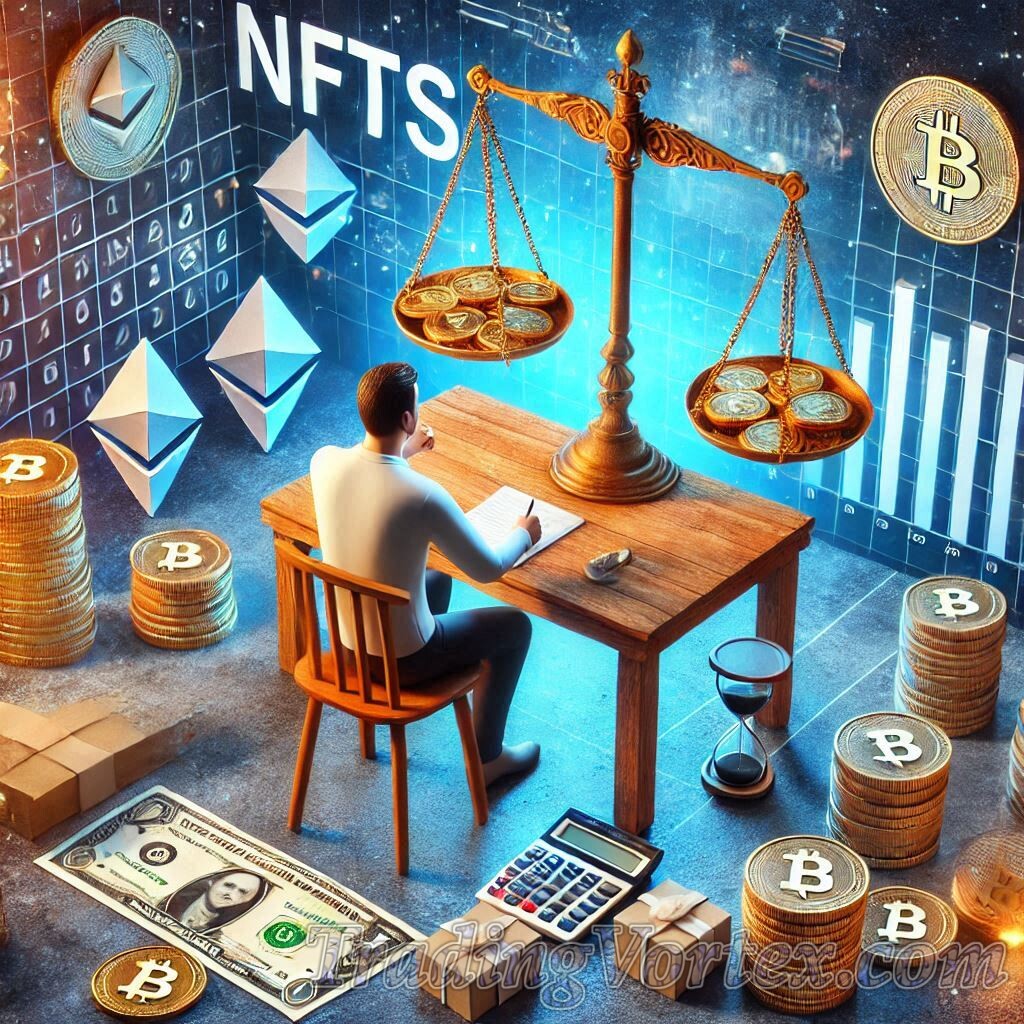
Why Choose NFT Staking?
Earn Passive Income with Minimal Effort:
Who doesn’t love earning while doing virtually nothing? NFT staking turns your idle digital assets into productive ones, enabling you to generate rewards while holding onto your NFTs. Typically, staking rewards come in the form of cryptocurrency, governance tokens, or additional NFTs. The process is simple: by locking your NFTs in a staking platform or protocol, you earn returns over time.
Enhance the Utility of Your NFTs:
Staking NFTs often goes beyond financial rewards – it can enhance the utility of your assets. Many NFT projects incentivize staking by offering exclusive perks to participants. For example:
- Access to Governance: Some platforms provide governance tokens in exchange for staking, allowing holders to vote on critical project decisions. This gives stakers a voice in shaping the future of the projects they’re invested in.
- Exclusive Experiences: Staking can unlock access to VIP events, limited-edition NFTs, or unique content that non-stakers don’t get. This added value strengthens your connection to the project and its community.
For gamers, staking NFTs from blockchain-based games like Axie Infinity or Illuvium can grant in-game advantages, such as rare items, power-ups, or early access to new features, further enriching the experience.
Support and Strengthen Blockchain Ecosystems:
By staking NFTs, you contribute to the stability and functionality of the blockchain networks powering these assets. For proof-of-stake (PoS) platforms, staking ensures the network remains secure and efficient. This active participation helps sustain projects you’re passionate about, ensuring their long-term success and growth.
As a bonus, some platforms offer environmental incentives, allowing stakers to support eco-friendly blockchain technologies that use significantly less energy compared to traditional proof-of-work (PoW) systems.
Long-Term Potential for Value Appreciation:
While staking NFTs generates immediate rewards, there’s also the potential for long-term appreciation. As the ecosystem matures and demand for certain NFTs grows, the value of your staked assets and the tokens you earn could increase significantly. For example, limited-edition or high-utility NFTs may appreciate over time, especially if they’re tied to popular brands or successful projects.
Challenges of NFT Staking:
Market Volatility: How It Affects Your Rewards?
The crypto and NFT markets are notorious for their volatility. While staking may generate steady rewards, the value of those rewards is subject to fluctuation. For instance, if the cryptocurrency earned through staking experiences a sudden price drop, the monetary value of your returns could diminish significantly.
Additionally, the value of your staked NFTs may also decrease due to market trends, making it essential to carefully evaluate the projects you choose to stake with. Prioritize projects with strong fundamentals and active communities to minimize the impact of market downturns.
Liquidity Constraints During Lock-Up Periods:
One of the biggest drawbacks of NFT staking is the lack of liquidity. Most staking platforms require you to lock up your NFTs for a predetermined period, which can range from weeks to months. During this time, you won’t be able to sell or trade your NFTs – even if an attractive offer comes your way.
This illiquidity can be particularly problematic in fast-moving markets, where opportunities to sell your NFTs at a premium might arise unexpectedly. To mitigate this, consider staking only NFTs that you’re comfortable holding long-term, and avoid staking assets you may need to access quickly.
Security Risks – Smart Contract Vulnerabilities:
NFT staking involves interacting with smart contracts, which, while designed to be secure, are not immune to risks. Smart contracts can contain coding errors or vulnerabilities that hackers could exploit, potentially leading to the loss of your staked assets.
In 2022 alone, over $2 billion was lost due to exploits in DeFi platforms, including staking protocols. This underscores the importance of researching the security track record of any platform you plan to use. Opt for platforms that have undergone rigorous third-party audits and maintain active bug bounty programs to minimize your exposure to such risks.
Platform Reliability and Longevity:
The NFT staking space is still relatively new, and not all platforms are built to last. Some may lack the resources or user base needed to sustain long-term operations, while others might face regulatory scrutiny or competition that forces them to shut down. If a platform you’re using goes offline, you could lose access to your staked assets or any pending rewards.
To reduce this risk, stick to well-established platforms with a proven history of reliability, strong partnerships, and transparent management teams.
Conclusion:
NFT staking offers an exciting way to generate passive income, unlock unique perks, and contribute to the growth of blockchain ecosystems. However, it’s not without its risks, including market volatility, liquidity constraints, and potential security issues. By carefully evaluating the projects and platforms you engage with and diversifying your investments, you can maximize the benefits of NFT staking while mitigating the challenges.
Whether you’re a seasoned crypto investor or a newcomer exploring the world of NFTs, staking can be a valuable addition to your strategy – just make sure you go in with your eyes open and a clear understanding of the risks and rewards.
The Ups and Downs of NFT Flipping:
NFT flipping, the practice of buying digital assets with the aim of reselling them for a profit, has become one of the most buzzworthy strategies in the cryptocurrency and blockchain world. For those who know how to navigate the space, flipping can result in significant short-term profits, and with the explosive growth of the NFT market, there are countless opportunities to capitalize on. However, like any investment strategy, NFT flipping comes with its own set of risks. Whether you’re a seasoned investor or just getting your feet wet in the world of NFTs, it’s important to understand both the upsides and the pitfalls of this strategy before diving in.
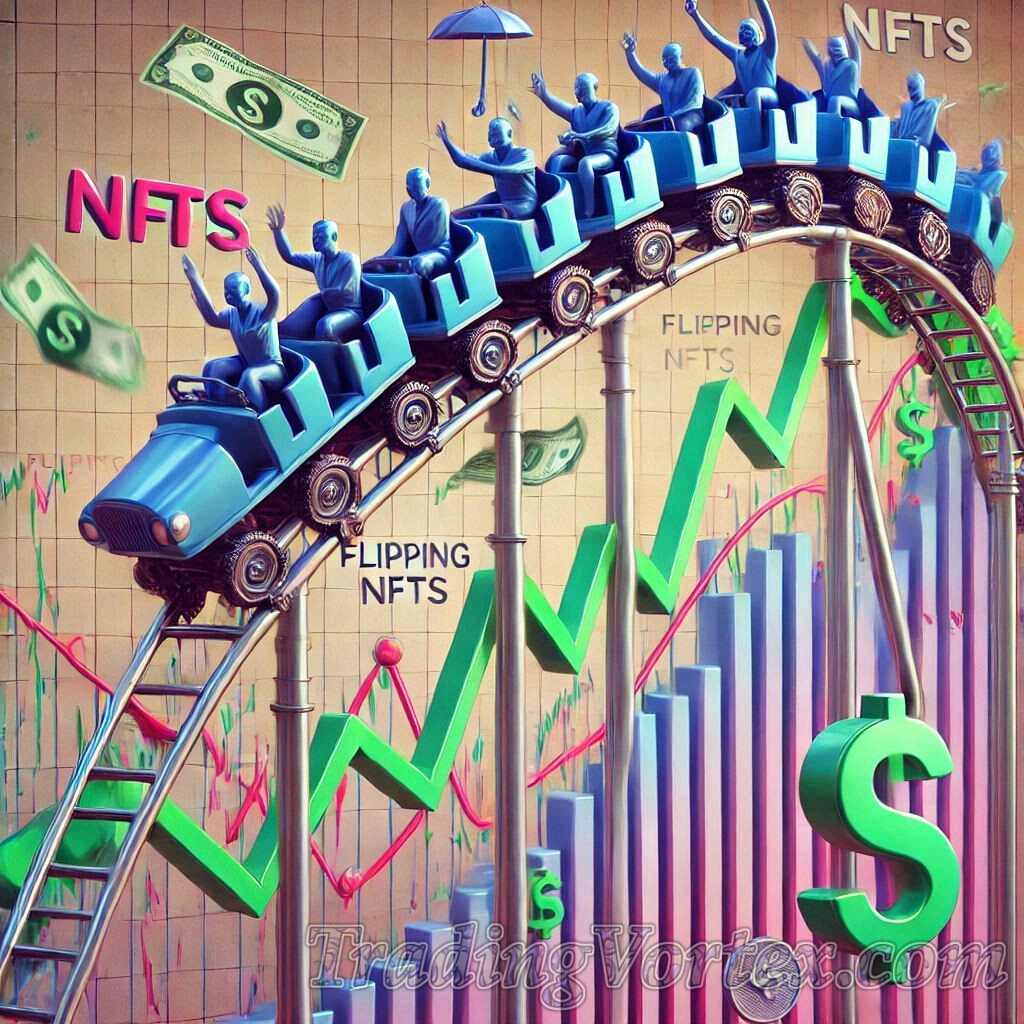
Why NFT Flipping is a Popular Strategy:
High Potential for Short-Term Gains:
One of the main reasons NFT flipping has gained popularity is the high potential for short-term profits. Some flippers have seen returns of several times their initial investment, thanks to market hype or the rapid appreciation of certain digital assets. For example, NFTs associated with celebrity endorsements, art drops, or viral trends can see their prices soar in a matter of hours or days. In fact, some NFT collections have exploded in value so quickly that resellers could double, triple, or even quadruple their investment almost overnight.
However, as with all speculative markets, this potential for high returns is coupled with a significant level of risk. The value of NFTs can be highly volatile, and prices can crash just as fast as they rise. As the NFT market matures, the opportunities for massive gains may become rarer, and flippers may need to develop more refined strategies to keep up with shifting trends and market dynamics.
Flexibility and Variety in Investment Opportunities:
The NFT space is incredibly diverse, offering a wide variety of digital assets that appeal to different kinds of investors. Whether you're into art, gaming, music, or even virtual real estate, there's something for everyone. This variety allows NFT flippers to specialize in specific niches they are passionate about, which can give them a competitive edge when it comes to identifying valuable assets.
Additionally, the relatively low cost of entry for certain NFTs makes flipping more accessible to a wider audience. For example, rather than purchasing high-priced art NFTs from well-known creators, flippers can target up-and-coming projects or collectible NFTs from smaller, lesser-known creators, potentially securing these assets at a bargain and flipping them for a profit once they gain popularity.
The flexibility and wide range of opportunities allow NFT flippers to tailor their strategies based on their own expertise and interests, creating an engaging and dynamic experience. And, as the NFT space continues to evolve, new investment opportunities are sure to arise, keeping the flipping game fresh and exciting.
Engaging with Exciting NFT Projects:
Flipping NFTs also offers the opportunity to be part of exciting, innovative projects. Many NFT projects are tied to unique art drops, games, or virtual worlds, allowing flippers to engage with these projects in a meaningful way. By jumping on a promising NFT early, flippers can gain access to exclusive content, early-bird perks, or limited-edition assets that are often only available to those who take part in the initial offering.
Being part of a community-driven project, particularly in the realm of gaming or virtual worlds, can offer a sense of belonging and involvement. In some cases, the NFTs that flippers buy and sell could even be tied to future use cases, such as rare in-game items or collectibles that hold additional value in a game’s ecosystem. Engaging in this ecosystem as a flipper not only allows for potential financial rewards but also opens up opportunities to be an early participant in something groundbreaking.
Risks Every NFT Flipper Should Know:
Market Speculation and Unpredictability:
The NFT market is inherently speculative, and as with any speculative asset class, the value of NFTs can swing wildly in both directions. While some assets may skyrocket in value, others may languish or crash entirely. This unpredictability can be frustrating for flippers, particularly if they’ve invested in an NFT hoping for a quick return, only to see it lose value before they have a chance to sell.
Several factors can influence the value of an NFT, such as market trends, influencer endorsements, celebrity involvement, or sudden changes in consumer sentiment. Additionally, the rise and fall of cryptocurrency prices can also impact the NFT market, as the two are closely linked. For example, the NFT market saw significant fluctuations in 2022, partly due to the decline in Bitcoin and Ethereum prices, leading some assets to lose value rapidly.
This volatility means that timing is everything when it comes to flipping NFTs. What may look like a great investment today might not be so profitable tomorrow. Without the ability to accurately predict the future trajectory of a particular NFT or collection, flippers are exposed to a great deal of uncertainty.
The Time-Intensive Nature of Researching NFTs:
While flipping NFTs can be highly profitable, it also requires significant research. Identifying the right assets to flip is more than just picking the latest trendy art or collectible; it’s about understanding the market demand, the potential for growth, the credibility of the creator, and the community surrounding the project.
Flippers must also stay on top of market trends and track upcoming NFT drops or sales that may present new flipping opportunities. Monitoring social media channels, NFT marketplaces, and influencers’ activity is essential to staying ahead of the curve.
For those without the time or expertise to research these assets, flipping can feel more like gambling than a strategic investment. Without proper research, it’s easy to end up with NFTs that fail to gain value or become stuck with assets that don’t sell as expected.
Financial Losses from Misjudged Market Trends:
NFT flipping carries the risk of significant financial losses, particularly for those who misjudge market trends. As the market becomes more competitive, it may be tempting to chase “hot” trends or buy into high-demand projects, but the reality is that not all NFTs will see continued appreciation. For example, a drop in interest for a particular project or collection can cause prices to plummet, leaving flippers holding onto assets that have lost their value.
Additionally, transaction fees on NFT marketplaces, especially Ethereum-based platforms, can eat into profits and add another layer of risk. With high gas fees, even a successful flip might not yield the expected returns if the cost of executing the transaction is too high.
Misjudging the market, buying into the wrong project, or simply holding onto an NFT too long before selling can lead to losses that might outweigh initial profits. To minimize this risk, it’s important to have a well-thought-out strategy, maintain realistic expectations, and know when to cut losses and move on.
Conclusion:
NFT flipping can be an exciting and potentially profitable venture, offering opportunities for quick gains and the thrill of engaging with innovative digital assets. However, it’s not a guaranteed path to wealth. The speculative nature of the market, the time and effort required for research, and the unpredictability of trends all contribute to the risks associated with flipping NFTs.
As with any investment, the key to success lies in research, strategy, and timing. By staying informed, understanding market cycles, and managing risk effectively, NFT flippers can maximize their chances of success while minimizing the impact of potential losses. Whether you’re just starting or have been flipping for a while, remember: the NFT space is evolving, and there are always new opportunities on the horizon.
How to Choose Between NFT Staking and Flipping:
Choosing between NFT staking and flipping is a crucial decision for anyone navigating the NFT space in 2025. Whether you're just getting started or have already made your mark in the digital asset world, understanding the differences and evaluating them based on your own goals and preferences will make all the difference in your long-term success. In this section, we will dive deeper into how to evaluate the market, align your strategy with your personal objectives, and stay ahead of regulatory changes to help you make an informed, confident decision.
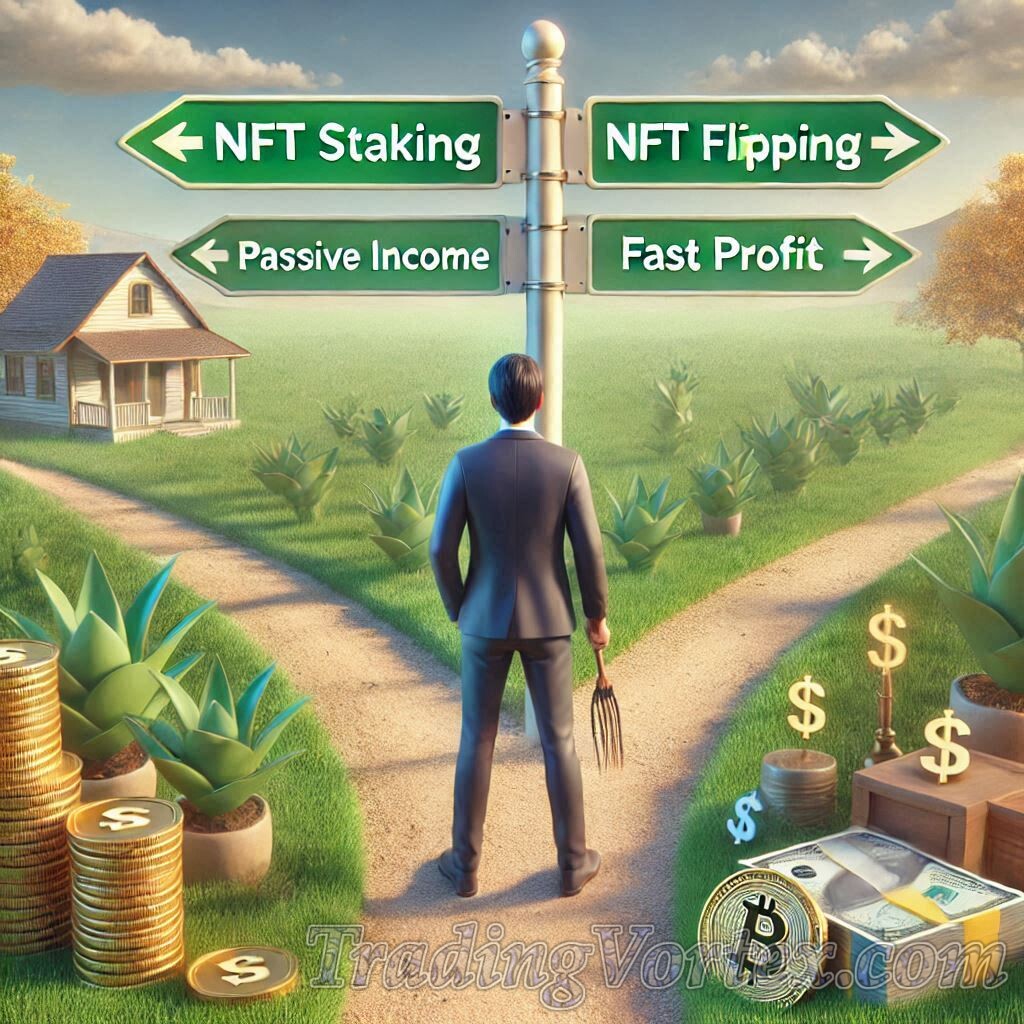
Evaluating the NFT Market in 2025:
Market Cycles and Their Impact on Returns:
The NFT market, like any other investment arena, follows cycles of boom and bust. However, 2025 is marked by a shift in the NFT landscape. As NFTs move beyond speculative assets into more utility-driven applications, we see stronger growth in long-term value compared to speculative “flip” opportunities. According to the latest market data, NFTs related to gaming, virtual real estate, and other utility-based ecosystems are expected to gain traction. This maturation means that short-term flipping strategies might face more volatility, while staking provides more predictable, albeit slower, returns.
Understanding these market cycles is key to selecting the right approach for your investment. If you’re hoping for a quick win in a hot market, flipping may be appealing. However, in a market that’s gradually maturing, staking could offer more consistent and stable returns over time.
Choosing the Right Strategy for Current Conditions:
Your strategy should align with where you think the market is heading and what conditions are most favorable. If you believe that NFTs will continue to be valuable in the long term and want to participate in ecosystem growth, staking could be the better fit. However, if you're looking to capitalize on hot trends and can handle the ups and downs of market speculation, flipping could offer higher short-term rewards, but with greater risk.
Aligning Your Strategy with Investment Goals:
Risk Tolerance – Passive vs. Active Strategies:
Your personal risk tolerance should be one of the main factors guiding your decision. NFT flipping is an active, high-risk strategy that involves buying and selling frequently. It requires staying on top of market trends, analyzing NFT projects, and timing the market well. Think of it like being a day trader in the stock market: you can make big wins, but you’re also exposed to potential losses.
In contrast, NFT staking is a more passive approach. Once you acquire the NFTs and lock them into staking platforms, you can sit back and watch your assets generate passive income over time. While staking may have a lower risk profile, it also tends to offer lower, steadier returns. If you’re someone who prefers a hands-off approach and is comfortable with waiting for long-term gains, staking could be your ideal strategy.
Time Commitment and Expertise Needed:
Flipping NFTs demands a significant amount of time and effort. If you want to succeed at flipping, you must constantly stay updated on new NFT drops, analyze trends, monitor market movements, and understand community sentiment. This requires a deep knowledge of the NFT ecosystem, and it’s important to invest time in learning about upcoming projects and identifying undervalued assets. It’s essentially like being a full-time trader – your time is your investment.
On the flip side, staking is a strategy that can be more aligned with people who don’t have time to actively monitor the market but still want to benefit from NFTs. Once you've staked your NFTs, your involvement is limited to periodic checks on your rewards. While some technical knowledge is still required to understand staking mechanisms and platforms, it doesn't demand as much attention as flipping does.
Staying Ahead of Regulatory Changes:
How to Adapt to Legal Updates in the NFT Space:
The NFT space is still in its early stages in terms of regulation, and legal frameworks are evolving quickly. In 2025, it's expected that clearer guidelines will emerge regarding ownership, copyright, and taxes. These updates will impact both staking and flipping strategies, especially for investors who want to stay on the right side of the law.
For example, NFT staking could involve income reporting, with earnings being taxed as passive income. Similarly, flipping could involve short-term capital gains tax. Staying on top of these changes will be key, as failing to adhere to tax laws or intellectual property rules could result in penalties or even loss of assets.
It’s important to stay informed by following reliable sources of information about NFT regulations. Platforms like CoinDesk and NFT Now provide valuable updates and insights on regulatory shifts. Make sure to track new laws in the regions where you are operating and ensure compliance for any staking platforms you choose or flipping transactions you make.
Ensuring Compliance for Safe Investments:
Legal and regulatory considerations should never be an afterthought. In fact, ensuring compliance is one of the best ways to safeguard your investments. As you decide between staking or flipping, it’s essential to be cautious about choosing projects and platforms that have strong legal frameworks. This includes researching whether the project has been audited, its compliance with intellectual property laws, and the platform’s history with user protection.
The risk of losing assets due to non-compliance is a risk no investor wants to take. Take the time to verify the legitimacy of the platforms you use for both staking and flipping. Ensuring that they have security protocols in place will protect your assets, and making sure they comply with tax regulations will keep you in the clear.
Conclusion:
Choosing between NFT staking and flipping ultimately boils down to your investment style, risk tolerance, and how much time you are willing to commit. Evaluating market conditions, aligning your strategy with your goals, and staying informed about legal changes will ensure that you are well-equipped to make the right decision for your portfolio in 2025. Whether you decide to passively earn rewards through staking or chase quick profits through flipping, being adaptable, informed, and strategic will increase your chances of success.
Pro Tips for Success in NFT Staking and Flipping:
Venturing into NFT staking or flipping can feel like navigating a maze of opportunities and risks. But with the right strategies, you can maximize your returns and avoid common pitfalls. Here’s how you can step up your game and thrive in these fast-paced NFT markets.

Mastering NFT Staking:
Diversify Your Staked NFTs Across Platforms:
Relying on a single platform for staking your NFTs is like betting all your chips on one card: it’s risky. Diversification allows you to spread the risk while increasing your potential returns. Choose platforms with strong reputations, robust security, and clear reward structures. Look into staking opportunities across multiple blockchains or NFT ecosystems, as different platforms often have varying levels of rewards, fees, and features. This approach not only mitigates risks but also broadens your earning potential.
Monitor Performance and Adjust Your Strategy:
NFT staking isn’t a “set it and forget it” strategy. Keep a close eye on your staked NFTs and regularly evaluate their performance. Rewards can fluctuate based on platform activity, token demand, or even market sentiment. If a platform's reward rates drop or security concerns arise, don’t hesitate to pivot to a more lucrative or safer alternative. Staying adaptable is key to maintaining consistent returns in a dynamic market.
Protect Your NFTs with Strong Security Measures:
Think of your NFTs as prized assets. Protecting them requires robust security practices. Use cold wallets or hardware wallets for storing your NFTs before staking, as these provide an extra layer of defense against hacking attempts. Always enable two-factor authentication on your staking platform accounts and stay alert to phishing schemes and fake platforms that promise sky-high rewards. Security should never be an afterthought – investing in safety now prevents costly mistakes later.
Winning at NFT Flipping:
Identify Undervalued NFTs with High Potential:
The essence of flipping lies in finding hidden gems before they hit the mainstream. Spotting undervalued NFTs requires deep research and a sharp eye for trends. Start by evaluating the project’s fundamentals: Does it have a dedicated community? A clear roadmap? Real utility or strong cultural relevance? Keep an eye on new launches, trending collections, and NFTs backed by notable creators or brands. Being early in promising projects often leads to higher profit margins.
Use Analytics Tools to Track Trends and Opportunities:
Successful flippers leverage analytics tools to stay ahead of the curve. These tools can track trading volumes, floor prices, rarity rankings, and trending collections. By analyzing market data, you can identify patterns, such as sudden spikes in demand or projects gaining traction. Combining these insights with your instincts and research ensures you make data-driven decisions instead of relying purely on speculation.
Set Realistic Profit Targets and Exit Strategies:
One of the biggest mistakes flippers make is holding on too long, waiting for an NFT’s value to skyrocket. While it’s tempting to aim for massive profits, unrealistic expectations often lead to missed opportunities. Set clear, achievable profit targets for each NFT you buy and establish an exit strategy before you even make the purchase. Knowing when to sell – whether the market dips or hits your target price – ensures you lock in gains and minimize risks.
General Tips for Both Strategies:
Stay Informed About the NFT Market:
The NFT market evolves rapidly, and staying informed is critical. Regularly follow market updates, join community forums, and participate in Discord or Twitter spaces to hear the latest from industry insiders. Being part of the conversation often gives you an edge, as you’ll learn about emerging trends, valuable projects, and potential pitfalls.
Understand Your Risk Tolerance:
Both staking and flipping come with inherent risks, but the level of risk varies significantly. If you prefer a hands-off, low-risk approach, staking may align better with your goals. On the other hand, if you thrive on market speculation and enjoy active trading, flipping might be the way to go. Assess your risk tolerance before diving into either strategy and align your investments accordingly.
Be Patient and Play the Long Game:
While flipping offers the allure of quick profits, not every investment will pay off immediately. Similarly, staking rewards accumulate over time. Patience is a virtue in both strategies – don’t rush into decisions based on FOMO (fear of missing out). Take your time to evaluate opportunities, plan your moves, and trust the process.
Final Thoughts:
Mastering NFT staking and flipping requires a mix of research, adaptability, and strategic planning. Whether you're in it for passive income or the thrill of short-term gains, these pro tips can help you maximize your returns while navigating the ups and downs of the NFT space. With the right mindset and approach, you can build a solid foundation for success in this ever-evolving market.
Real-Life Case Studies – Lessons from Top Investors:
Diving into the world of NFTs can feel like exploring uncharted waters. To help navigate this dynamic landscape, let's delve into real-life stories of investors who've made significant strides in NFT staking and flipping. Their experiences offer valuable lessons for both newcomers and seasoned traders.
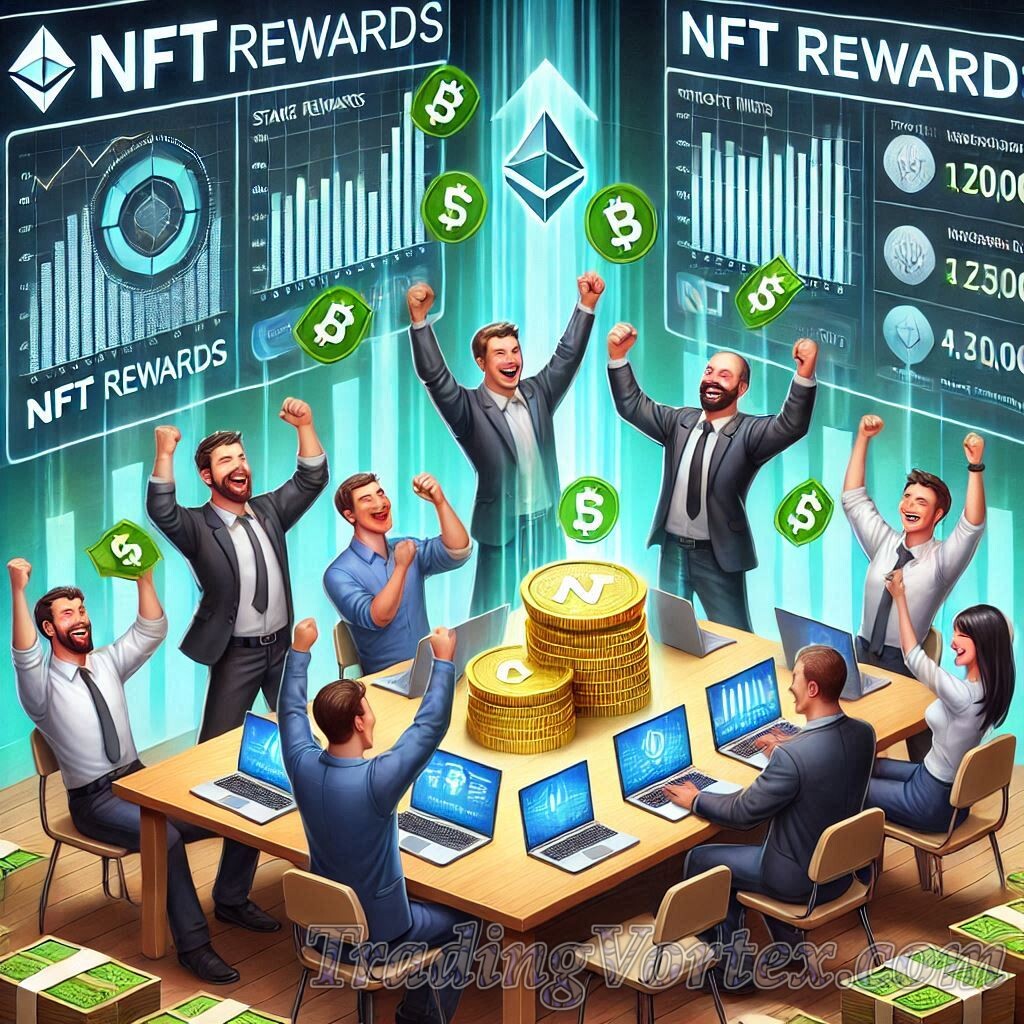
Successful NFT Staking Stories:
From Photographer to NFT Success: Brittany Pierre, a 36-year-old photographer, transformed her financial landscape by embracing NFTs. Over nine months, she earned over $109,000 by selling her own NFTs and flipping others for profit. Pierre's journey underscores the potential of NFTs to empower artists and creators, turning passion into substantial income.
Key Takeaways:
- Leverage Personal Creativity: Artists can monetize their work directly through NFTs, reaching global audiences without intermediaries.
- Stay Informed: Understanding market trends and the value of digital art can lead to profitable opportunities.
NFT Flipping Success Stories:
Turning $2K into Nearly $500K – A Trader’s Tale: An anonymous NFT trader shared their remarkable journey of converting an initial investment of 0.6 ETH (approximately $2,000) into over 150 ETH (around $500,000) within a few months. This success was achieved without relying on early access or exclusive opportunities, highlighting the potential of strategic buying and selling.
Key Takeaways:
- Strategic Timing: Entering and exiting the market at opportune moments is crucial for maximizing profits.
- Research and Patience: Diligent research and patience can yield significant returns, even without insider advantages.
Lessons Learned:
These stories highlight several critical lessons for aspiring NFT investors:
- Diversify Investments: Engaging in both staking and flipping can balance risk and reward, providing multiple income streams.
- Continuous Learning: The NFT landscape evolves rapidly; staying informed about market trends, technological advancements, and regulatory changes is essential.
- Community Engagement: Building and participating in NFT communities can offer support, insights, and opportunities for collaboration.
By learning from these real-life examples, investors can better navigate the NFT market, making informed decisions that align with their financial goals and risk tolerance.
What’s Next for NFT Staking and Flipping?
As we look toward 2025, the NFT landscape is poised for significant evolution. Both staking and flipping are set to undergo transformations influenced by technological advancements, market dynamics, and emerging trends. Let's explore what the future holds for these investment strategies.

Predictions for NFT Staking in 2025:
Emerging Reward Models and Enhanced Staking Platforms:
By 2025, staking is anticipated to become more accessible and rewarding. The rise of Delegated Proof of Stake (DPoS) systems is expected to simplify participation, allowing token holders to delegate their staking rights to validators. This approach not only lowers the barrier to entry but also enhances network security and efficiency. Additionally, the proliferation of staking pools will enable smaller investors to combine resources, optimizing returns and minimizing risks.
How DeFi is Shaping the Future of Staking:
The integration of Decentralized Finance (DeFi) protocols with NFT staking platforms is set to revolutionize the staking experience. Innovations such as liquidity staking and cross-platform interoperability will provide stakers with more flexibility and higher yield opportunities. As DeFi continues to mature, we can expect more sophisticated financial instruments that leverage NFT assets, further blurring the lines between traditional finance and the digital asset ecosystem.
The Future of NFT Flipping:
Upcoming Market Trends That Will Influence Flipping:
The NFT market is projected to shift towards utility-driven assets by 2025. Collectors and investors will increasingly seek NFTs that offer tangible benefits, such as access to exclusive content, real-world privileges, or revenue-sharing models. This trend will influence flipping strategies, as the value of NFTs will be more closely tied to their practical applications and the communities they represent.
The Role of AI in Identifying Flipping Opportunities:
Artificial Intelligence (AI) is poised to become a crucial tool for NFT flippers. Advanced algorithms can analyze vast datasets to identify emerging trends, assess market sentiment, and predict asset appreciation. By leveraging AI, traders can make more informed decisions, optimize timing for buys and sells, and mitigate risks associated with market volatility. The integration of AI into trading platforms will democratize access to sophisticated analytics, leveling the playing field for individual investors.
As we approach 2025, staying informed and adaptable will be key to navigating the evolving NFT landscape. Whether you're staking for passive income or flipping for profits, understanding these emerging trends will position you to capitalize on new opportunities in the digital asset space.
Choosing the Right NFT Strategy for 2025: Staking or Flipping?
As we venture into 2025, the NFT landscape continues to evolve, presenting both opportunities and challenges for investors. Whether you're inclined towards the steady rewards of staking or the dynamic gains from flipping, understanding the nuances of each strategy is crucial.
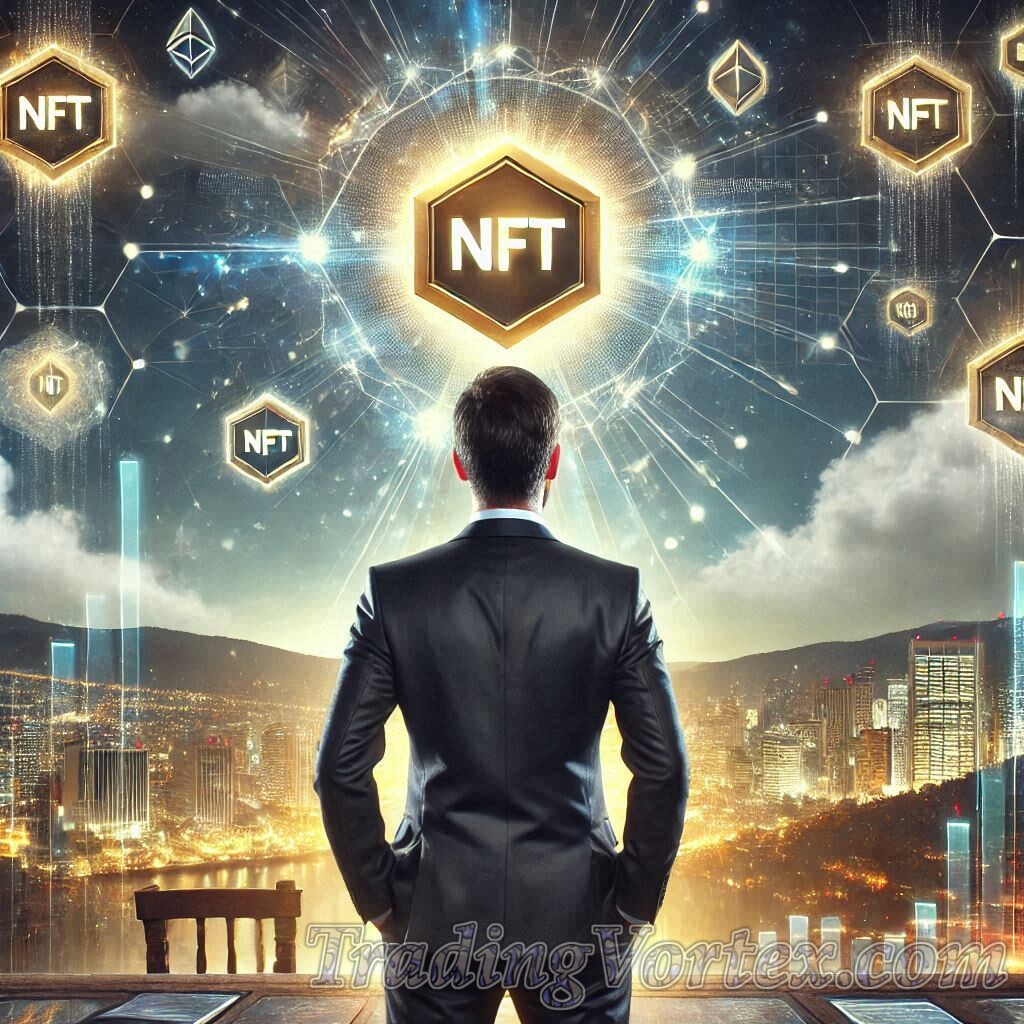
Comparing NFT Staking and Flipping: Which Strategy is Best for You?
Choosing between staking and flipping hinges on your individual investment goals and risk tolerance.
- Staking offers a more conservative approach, providing consistent returns over time – think of it as planting a tree and patiently waiting for it to bear fruit.
- On the other hand, flipping is comparable to surfing – riding the waves of market trends for quick profits, which requires agility and a keen sense of timing.
By 2025, the NFT market is expected to be more utility-driven, moving beyond speculative trading to applications with tangible value.
Tips for Staying Informed and Adapting to Market Changes:
The NFT realm is dynamic, and staying informed is your best defense against volatility. Regularly engage with reputable sources, participate in community discussions, and leverage analytical tools to monitor market trends. With the anticipated rise of utility-driven NFTs, focusing on assets that offer tangible benefits can provide a competitive edge.
Final Thoughts – Thriving in the Dynamic NFT Space:
Embarking on your NFT investment journey in 2025 requires a blend of knowledge, adaptability, and strategic planning. Whether you choose staking, flipping, or a combination of both, aligning your approach with market trends and personal objectives is key. Remember, the NFT space is as much about community and innovation as it is about financial gain. Stay curious, stay informed, and most importantly, enjoy the ride.
Frequently Asked Questions – NFT Staking vs. NFT Flipping:
The world of NFTs is filled with potential but can be a bit overwhelming, especially if you’re deciding between staking and flipping. Below are the most common questions answered to help you navigate this exciting space confidently.
Q1. What is NFT staking?
NFT staking lets you lock your NFTs on a platform to earn passive rewards, like cryptocurrency, governance tokens, or even additional NFTs. It’s like putting your digital assets to work while you sit back and watch your portfolio grow. This strategy supports the blockchain ecosystem while offering steady income.
Q2. How does NFT flipping work?
NFT flipping is the art of buying NFTs at a lower price and selling them for profit when their value rises. Timing, market awareness, and strong research are critical for success. Think of flipping as a fast-paced, high-reward strategy for those who enjoy active trading and staying ahead of market trends.
Q3. Which is better for beginners: staking or flipping?
For beginners, staking is often a safer starting point. It provides predictable, passive income and requires less market knowledge. Flipping, while more lucrative for experienced traders, involves higher risks and demands time to analyze markets. Start with staking to get a feel for the NFT ecosystem before venturing into flipping.
Q4. What fees should I watch out for in NFT staking and flipping?
⇒ Staking Fees: Platforms may charge service fees or require gas fees for transactions.
⇒ Flipping Fees: Transaction fees, creator royalties, and gas fees apply each time you buy or sell NFTs.
Always calculate fees to ensure they don’t eat into your profits.
Q5. What are the risks of NFT staking?
⇒ Market Volatility: The value of staked NFTs and rewards can fluctuate.
⇒ Lock-Up Periods: Some platforms require you to lock NFTs, limiting your ability to sell quickly.
⇒ Platform Reliability: Risks of platform hacks or smart contract vulnerabilities exist. Always choose reputable platforms with strong security measures.
Q6. How can I find the best NFTs for flipping?
To identify high-potential NFTs, consider:
⇒ Community Activity: A strong, engaged community often signals demand.
⇒ Utility: NFTs with real-world benefits, like gaming integration, tend to perform well.
⇒ Rarity: Limited-edition collections often retain value better.
⇒ Credible Creators: Established creators or brands add credibility and demand.
Use tools like Rarity Tools, Nansen, or OpenSea analytics to track trends and opportunities.
Q7. Can I stake any NFT, or are there restrictions?
Not all NFTs are stakeable. Typically, staking is available for NFTs tied to specific ecosystems, such as blockchain games, metaverse projects, or DeFi platforms. Always check if the platform supports your NFT for staking.
Q8. Is combining staking and flipping a smart move?
Absolutely! Diversifying your strategies can help balance risks and maximize earnings. For instance, you can stake long-term NFTs for steady income while flipping others for quick profits. It’s like having both a steady paycheck and a side hustle.
Q9. What tools and platforms should I use for staking or flipping?
⇒ Staking Platforms: Platforms like Binance NFT, Rarible, or project-specific platforms (e.g., Axie Infinity).
⇒ Flipping Analytics: Use tools like OpenSea rankings, Dune Analytics, or Nansen to analyze market trends and spot opportunities.
Stay updated on platform reliability and user reviews before committing your assets.
Q10. How does the NFT market’s volatility affect staking and flipping?
⇒ Staking: Rewards may lose value during market downturns, but staking is generally less sensitive to short-term volatility.
⇒ Flipping: Market swings can create significant opportunities but also amplify risks. Timing and quick decision-making are crucial to capitalizing on volatility.
Q11. What are the tax implications of NFT staking and flipping?
Tax laws vary by country, but generally:
⇒ Staking Rewards: Often considered taxable income.
⇒ Flipping Profits: Typically subject to capital gains tax.
Consult a tax professional familiar with cryptocurrency regulations in your area to ensure compliance and avoid penalties.
Q12. How much time and effort do these strategies require?
⇒ Staking: A hands-off strategy that requires minimal time after setup.
⇒ Flipping: A time-intensive approach that demands research, monitoring, and quick decision-making.
Choose based on your availability and expertise.
Q13. How can I stay informed about NFT trends?
⇒ Community Engagement: Join active communities on Discord, Twitter, and Reddit.
⇒ Analytics Tools: Use Nansen, OpenSea, or Dune Analytics for real-time data.
⇒ Thought Leaders: Follow NFT influencers and analysts to get insights into emerging trends. Staying informed will give you a competitive edge.
Q14. Are there ethical concerns with flipping NFTs?
Yes, flipping can raise questions around price manipulation or speculative hype. Focus on ethical practices by choosing projects with long-term value and avoiding practices that exploit market vulnerabilities. Transparency and integrity are key to building credibility.
Q15. Is NFT flipping or staking suitable for long-term wealth building?
Both strategies can contribute to long-term wealth if approached thoughtfully. Staking is ideal for consistent income over time, while flipping offers higher but riskier returns. A balanced approach can ensure steady growth while capitalizing on high-value opportunities.
This extended FAQ section should help clarify your doubts and prepare you to thrive in the NFT market, whether you’re staking for passive income or flipping for quick profits. Adapt, research, and stay curious – success lies in staying ahead of the curve!
































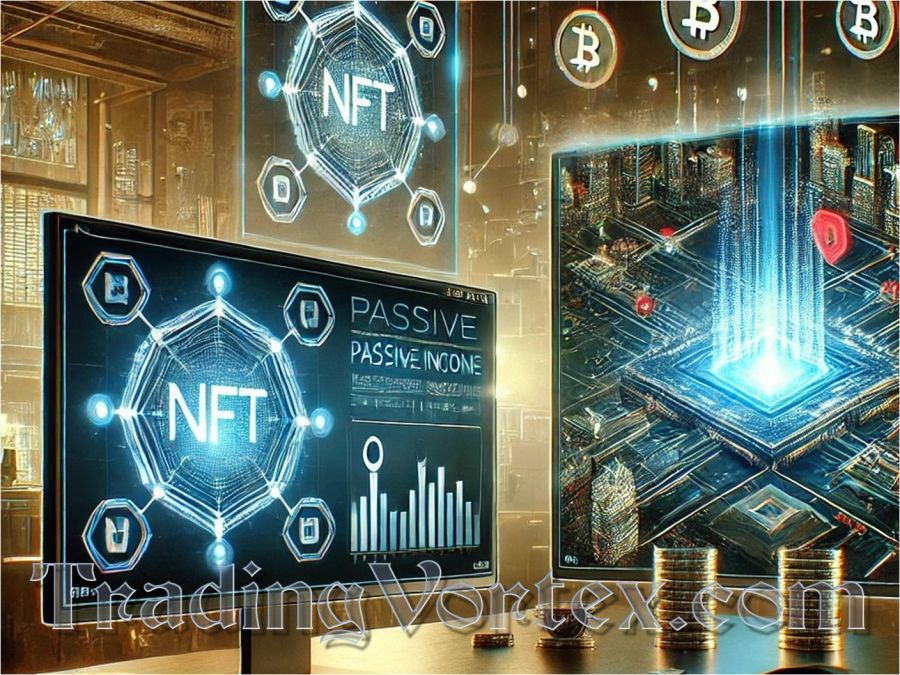




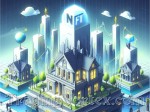


 TradingVortex.com® 2019 © All Rights Reserved.
TradingVortex.com® 2019 © All Rights Reserved.